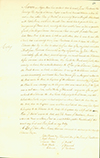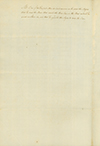Conflicting Accounts
The investigation into who attacked the HMS Gaspee began the morning of June 10th and continued for about 12 months. Governor Joseph Wanton, Deputy Governor Darius Sessions, Britain's Admiral Montagu, and an investigatory commission appointed by King George himself, took testimonies and received written accounts from men believed to have information about the attack.
Aaron Briggs, a young, indentured servant of African and perhaps Indigenous heritage, provided the most detailed description of the events of June 9th and 10th. However, his account was immediately discredited by Jack and Somerset, two other servants who worked with him, and by his master, Samuel Tompkins. George Brown and James Sabin, owner of the tavern where the attackers were said to have gathered, also gave accounts that differed from Aaron’s.
Learn about other key figures in the Gaspee attack and investigation in our Cast of Characters.

Primary Source Documents
Click on the thumbnails below to zoom in and explore these documents.
-

Testimony of Aaron Briggs, June/July 1772
“[I] rowed from Prudence…the evening his Majesty's schooner Gaspee was burnt... [I] met a man called Potter, of Bristol, in a rowing boat, with eight men, armed with pistols, guns, and clubs… I then got into Potter's boat by his desire; he told me… that he was to join other boats that was coming down from Providence, in order to burn the King's schooner that lay on shore. In about half an hour after, we joined seventeen boats from Providence, commanded, as they informed me, by John Brown...”
-

Testimony of Jack and Somerset, July 1772
“…on the night the schooner called the Gaspee was burnt the said Aaron was at home… in the same room and bed with [us] the whole of that night, having retired to bed together between nine and ten o'clock in the evening; and… [we] have never had the least hint, or information, from the said Aaron of his having any knowledge of the burning of the said schooner Gaspee, and that [we] are well assured that he knows nothing of the transaction.”
-

Deposition of Samuel Tompkins, July 1772
“…the same night that his Majesty’s schooner the Gaspee was burnt… Aaron remained in his house the whole of the night… with the rest of the servants in the family... and, also, very early in the morning of the 10th, the said Aaron, according to his usual custom, brought the cows into the yard to be milked… it absolutely impossible that the said Aaron should have been that night any where near the place where the schooner Gaspee was burnt…”
-

Letter from James Sabin to the Gaspee Commission, January 1773
“I could give no information relative to the assembling, arming, training or leading on the people concerned in destroying the schooner Gaspee. On the 9th day of June last at night I was employed at my house attending company, which were John Andrews, Esq., Judge of the court of Admiralty, John Cole, Esq., Mr. Hitchcock, and George Brown, who supped at my house and stayed there until two of the clock in the morning…”
-

Deposition of George Brown, June 1773
"… I had heard the said schooner was aground. But had not then the least suspicion that any mischief was intended to be done to said schooner, or any body on board her... And I further declare that I have not any knowledge directly or indirectly of any plans being laid to burn or otherwise destroy said schooner, or of any person concerned in so vile a crime, or wounding Lieutenant Dudingston."
Questions and activities
Read the testimonies and letters and decide who you think was telling the truth. Consider the possible motivations of each of the men involved.
Aaron was the only person who named individuals who participated in the attack. Why do you think no one else did?
What can you infer about the lives of Black and Indigenous indentured servants from the testimonies?
Aaron’s testimony was given after he ran away from Samuel Tompkins. What does this suggest about his life on Prudence Island?
What is the difference between indenture and enslavement? (Note: sometimes there was little difference between the two for people of African and Indigenous ancestry.)


